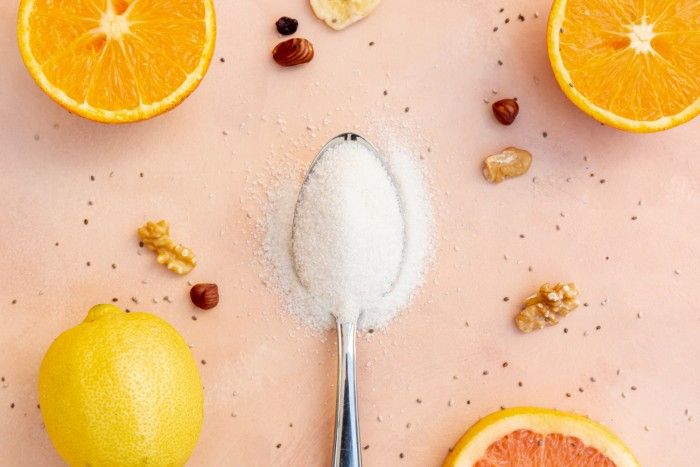Artificial Fructose: Hidden Sugar & Health Risks Explained
By NutrioTalk
Fructose: What It Is and Why It Matters
Fructose is a naturally occurring sugar found in fruits, vegetables, and honey. It’s sweet, easily digested, and often part of a healthy diet when consumed in its natural form. But there's another side to the story — the highly processed version of fructose that sneaks into many modern foods. This is where concerns begin, especially when it comes to your long-term health.

Why Fruit-Based Fructose Is the Good Kind
When you eat fruit, you're not just getting sugar — you're also getting fiber, water, vitamins, antioxidants, and other plant compounds. These work together to slow down sugar absorption and reduce the impact on your blood sugar and liver. That’s why fructose from whole fruit is considered safe, even beneficial, when eaten in moderation.
For example: A banana delivers natural sugar along with potassium and fiber — a nourishing, slow-burning energy source that doesn’t overload your system.
How Much Is Too Much?What Is Artificial Fructose and Where Does It Show Up?
Artificial fructose refers to highly refined forms of sugar added to processed foods and drinks. The biggest culprits include:
• High-Fructose Corn Syrup (HFCS) – Common in sodas, candy, and packaged snacks
• Crystalline Fructose – Found in “low-fat” and “natural” sweetened products
• Fruit Juice Concentrates – Often added to granola bars, sauces, and smoothies
These forms are stripped of fiber and nutrients, hitting your system fast — and hard.
Fructose vs. Glucose: Why They Act Differently
Your body treats fructose and glucose differently. Glucose is absorbed and used by nearly every cell in your body. Fructose, on the other hand, goes straight to the liver. If you have too much, your liver turns it into fat — some of which can stay in the liver and cause problems.
This difference also means that fructose doesn’t trigger insulin or help you feel full the same way glucose does. Over time, that can lead to overeating and weight gain.
Is Fructose Worse Than Glucose?
In many ways, yes. Because fructose bypasses insulin and satiety signals, it's easier to overconsume — especially when it comes from sugary drinks or sweets. It can build up in the liver, contribute to insulin resistance, and play a role in serious health problems like non-alcoholic fatty liver disease (NAFLD), obesity, and type 2 diabetes.
Health Risks of Too Much Artificial Fructose
When consumed in excess — especially in its artificial forms — fructose can:
• Lead to weight gain and belly fat
• Increase triglycerides and bad cholesterol
• Raise the risk of type 2 diabetes
• Contribute to liver fat buildup (NAFLD)
• Elevate blood pressure and uric acid levels
• Fuel chronic inflammation
And these effects can show up even if you're not overeating overall.
Whole Fruits vs. Processed Sugars: The Big Difference
Fruits provide a natural sugar package, rich in nutrients and fiber. This makes them filling and metabolically safer. Processed fructose, however, is added to foods without any of those benefits — leading to quicker spikes in liver fat and sugar overload.
Bottom line: You’re not doing your body any favors by trading fruit for processed sweets labeled “healthy” or “low fat.”
A Global Perspective on Fructose Consumption
In many countries — particularly in the West — sugary drinks and processed foods are now a major source of calories. This shift is closely linked to rising obesity and metabolic disease rates. Meanwhile, regions that eat more whole foods and less added sugar (like parts of the Mediterranean or Asia) continue to see lower rates of these conditions.
What Nutrition Experts Recommend
Most dietitians and health researchers agree: natural fructose from fruits is fine — even good for you — but added fructose from processed foods should be limited. Some simple strategies that work:
• Check the label: Watch for HFCS, fructose, or “fruit juice concentrate.”
• Rethink your drinks: Choose water or unsweetened beverages instead of soda or packaged juice.
• Eat whole fruits: They’re more filling and better for your blood sugar.
• Cook at home more: That way, you control what goes into your food.
Fructose Misconceptions — Busted
• “Fructose is always bad.”
Not true. In moderation and in whole fruits, it’s perfectly healthy.
• “Fruit juice is just as good as fruit.”
Nope. Juice lacks fiber and delivers a sugar hit that’s much faster.
•“Fructose doesn’t affect insulin.”
It may not spike insulin like glucose, but it still promotes fat buildup and insulin resistance over time.
Real-Life Example: A Shift That Helped
In one study, adults who swapped sugary drinks for whole fruits and water showed reduced liver fat, better blood sugar control, and improved energy within a few months. That’s a simple but powerful change anyone can make.
Takeaway: Make Fructose Work for You, Not Against You
• Choose whole fruits, not fruit-flavored snacks.
• Read labels and stay alert to hidden sugars.
• Prioritize real, unprocessed food.
• Watch your sweet drink intake — even the “natural” ones.
A little sweetness can be a part of a healthy life — as long as it comes from the right source.

